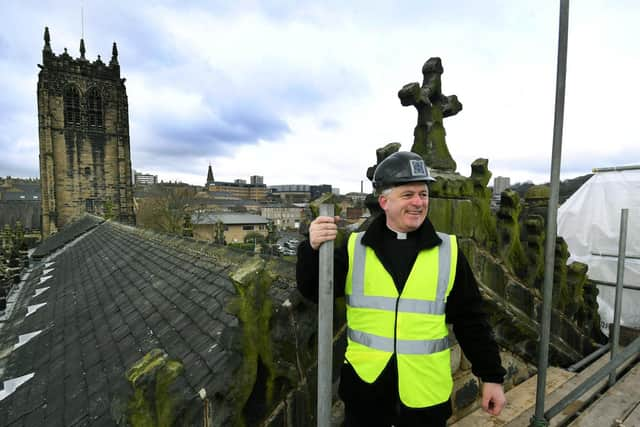Halifax Minster restoration project underway as workmen scale the roof for the first time in 100 years
and live on Freeview channel 276
That was around a century ago and when the local vicar climbed back up last month, only the nearby Piece Hall, where cloth was bought and sold on a weekend, remained.
“In a world where everything changes, there isn’t much left that roots us into something more permanent,” he reflected.
Advertisement
Hide AdAdvertisement
Hide Ad“We’re all searching for something solid. And this tower has seen civil war, two world wars and now a pandemic.”


It was the latter that made it possible for Canon Hilary Barber, Vicar of Halifax, to see out over the town once more.
Repairs to the 15th century tower had been out of the question until the Government announced its £1.57bn Cultural Recovery Fund to help the nation’s creative and heritage sectors ride the storm.
The Church of England was handed £10m of it to support cathedrals and major churches and £124,000 of that has gone to Halifax Minster – a figure it has match-funded from other sources.
Advertisement
Hide AdAdvertisement
Hide Ad“Stone replacement work on the tower has been on our shopping list for probably 20 years but we’ve never had the money to tackle the sort of work needed on a 900-year-old heritage asset,” Mr Barber said.
“When the fund was announced we were given 10 days’ notice to get an application in and we were very fortunate to be awarded enough to build scaffolding that gets us high up at last.”
The work now under way extends beyond the tower to the minster’s stained-glass windows which have been vandalised over the years and the installation of new guards for the 1645 Commonwealth Window.
The clock faces on the tower will also benefit from a facelift, with painters abseiling on ropes to reach them.
Advertisement
Hide AdAdvertisement
Hide AdBut as with many building jobs on previously hidden areas, the initial work revealed a can of worms.
The carved pinnacles atop the tower were discovered not even to have been fixed in place. “We found they were just sitting on a bed of sand. So we’ve been able to insert dowels to ensure they’re safe,” said Mr Barber. That and other setbacks – and the need to complete the work using traditional techniques sympathetic to the original materials – has meant that completion, originally due at the end of this month, has been put back to early summer.
The view from the top, once the scaffolders had done their work, was a sight to behold, the vicar said.
“You get a really strong sense up there of how this was the mother church for the whole of Calderdale.
Advertisement
Hide AdAdvertisement
Hide Ad“The ancient parish covered 124 square miles and for the first 300 years of its life it used to be the administration of law and order.
“Now in the 21st century it’s again a community asset, rather like medieval times.”
But the changes in the area the tower overlooks betray the scars of the centuries. Where once stood the chimneys and factories of the Industrial Revolution – the original Northern Powerhouse – now languish tyre depots, car parks and closed shops, some for the duration of the lockdown, others permanently.
“The view from even 100 years ago would be vastly different to what we see today,” Mr Barber said.
Advertisement
Hide AdAdvertisement
Hide AdHalifax Minster was a parish church until 12 years ago and considers itself the spiritual home of the newly celebrated Anne Lister, who was baptised and buried there.
The subject of the TV series Gentleman Jack brought more than 50,000 visitors in 2019 to celebrate the life of a woman considered the first modern lesbian.
The tower was a late addition to the church, having been built around 1450 to replace an earlier uncompleted structure. The minster was built in stages by Benedictine monks, beginning in the 12th century, with most of it completed around 1438.
In 1628, a corner of the tower was struck by lightning and the battlements damaged by falling stones.